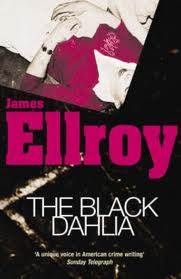Our book group choice for September 2009 is The Black Dahlia by James Ellroy. It is a fictionalized account of the real life murder of Elizabeth Short. Short’s body was found in an abandoned field near the famous Hollywood sign on January 15, 1947.  Despite a long and public investigation, the murder remains unsolved to this day. It is one of the most famous unsolved cases in American history. The novel follows Dwight “Bucky” Bleichert, an officer known more for his prowess in the boxing ring than his ability to uphold the law. He becomes partners with Lee Blanchard, a well-known and respected officer who is rising quickly in the police department. Bucky learns quickly at the hands of the more experienced Lee. He also falls in love with Lee’s live-in girlfriend, Kay Lake, a woman Lee met when he arrested and testified against her ex-boyfriend.
Despite a long and public investigation, the murder remains unsolved to this day. It is one of the most famous unsolved cases in American history. The novel follows Dwight “Bucky” Bleichert, an officer known more for his prowess in the boxing ring than his ability to uphold the law. He becomes partners with Lee Blanchard, a well-known and respected officer who is rising quickly in the police department. Bucky learns quickly at the hands of the more experienced Lee. He also falls in love with Lee’s live-in girlfriend, Kay Lake, a woman Lee met when he arrested and testified against her ex-boyfriend.
While investigating another crime, Bucky and Lee are among the first officers to respond when the body of Elizabeth Short is found. She has been mutilated and cut in half. Also, her mouth has been slashed open from ear to ear. Bucky and Lee are transferred to the case, and Lee becomes obsessed with finding the killer. His sister was murdered when he was a child, and Bucky believes Lee’s unwavering focus on the case is a result. Bucky instantly wants to be off the case, but in compromise he promises Lee one week on the case.
Eventually, Bucky’s investigation leads him to a bungalow in Hollywood, where it appears the investigation comes to an end. However, the haunting image in a painting leads Bucky to uncover a larger conspiracy, one in which he serves as an unwitting participant. The real killer is someone Bucky never suspected, and the conspiracy to conceal the killer’s connection to Betty could cost Bucky his career.
Discussion Questions
- Did you enjoy the book?
- The story is complex. Did you get confused? How did you keep things straight?
- In the prologue Bucky says Elizabeth Short is “at best a could-have-been — a tag that might equally apply to me.” Is this an accurate statement?
- What is the significance of the nicknames “Mr. Fire” and “Mr. Ice?”
- How does the Blanchard-Bleichert story apply to the Black Dahlia mystery? Why does Ellroy start there?
- What was your opinion of Lee at the beginning of The Black Dahlia? How does it change as Bucky finds out more about him? Was Lee a good guy or a bad guy? What is the best thing he did? The worst?
- What was your opinion of Bucky at the beginning? How does it change throughout the novel? In the end, do you like or dislike Bucky?
- What drives Bucky? Fame? Success? Something else? Why isn’t he able to keep fame and success long term? Do you think he will be able to hold onto love long term?
- In the beginning Bucky is not interested in the dahlia case. He requests to be transferred back to Warrants several times. What changes? At what point does the dahlia become an obsession?
- Why does the dahlia become an obsession for Bucky, Lee and so many others?
- Why does Bucky’s marriage fall apart? In what ways are Kay and Bucky playing roles? Is their relationship built on lies?
- Why does Bucky believe Madeleine’s alibi? Why is he drawn to her?
- Why does Madeleine continue to impersonate Elizabeth?
- Were you surprised by the solution to the dahlia murder? Why do you think Bucky chooses private justice?
- Why does Bucky let Ramona off free? Do you think that was the right decision?
- Why does Bucky turn Madeleine in even though it is his downfall as an officer? Why does he make her pay and not Ramona?
- As Bucky heads back to Kay he says “she had to know it was Elizabeth Short who was giving us our second chance.” What does this mean?
- In the final 20 pages the entire story is explained in entirety. Whilst undoubtedly clarifying, did it feel it an effective story-telling technique?
- Is this pulp fiction? Or literature? What makes it different?
- Have you read other Ellroy? Would you read more?
Individual Ratings
DKB Rating 





